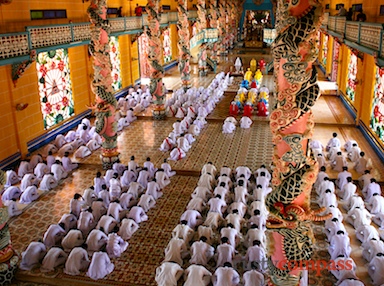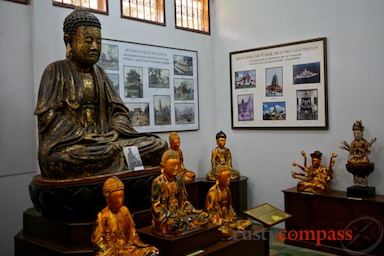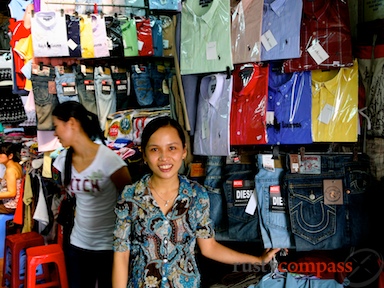For our most recent recommendations of things to see and do in Saigon, visit our see and do pages here.
Saigon is a city of few formal tourist sights - yet there are loads of things to do. You'll spend your time walking the streets, eating out, shopping, perhaps having a spa treatment and enjoying the friendly chaos of one of Asia's great buzzing cities. There are definitely a few sights worth visiting as well. Our favourites are the former Presidential Palace, now known as Reunification Palace and the War Remnants Museum. If time allows, take a look at some of the other options below as well. Eating will be a highlight of your time in Saigon so it's worth having a rough plan in mind on which restaurants you want to try.
Do as much as you can on foot. Saigon is not a great walking city - pavements are cluttered, motorcycles often mount them and it can be very hot. But all of the places listed below are close together and walking will definitely give you a better sense of the city. If you tire of walking or the heat gets to you, jump in a cyclo or a taxi. Cholon, Saigon's Chinatown is in a different part of the city about ten minutes away by cab.

Photo: Mark BowyerCao Dai Temple can be visited with Cu Chi in a full day from Saigon
Not far from Saigon, the Viet Cong tunnels at Cu Chi are also well worth a look. Allow half a day for these and visit the tunnels at Ben Duoc rather than the slightly closer more touristy complex and Benh Dinh. Many travellers also combine the Cu Chi tunnels with a visit to the Cao Dai Temple in Tay Ninh. It's a long day but it includes two very interesting sights and some beautiful rural scenes.
Day trips to My Tho in the Mekong Delta are also commonly taken from Saigon.
You can see the sights of Saigon in a full day - but two full days will give you a better sense of the place. Three nights is a good time to allow for Saigon including the Cu Chi tunnels and time for sampling the culinary fare, walking, shopping and relaxing. If you're planning to do a day trip to the Mekong Delta or to add the Cao Dai Temple to your Cu Chi trip, you'll need more time.
Reunification Palace - former Presidential Palace
The gates to this distinctive piece of 1960s Vietnamese architecture were the feature of some of the most viewed television footage of the last 35 years. On April 30 1975, North Vietnamese tanks crashed through them towards the then South Vietnamese Presidential Palace bringing to an end three decades of war and America's failed campaign to thwart communism in Indochina.
The Reunification Palace is now open for travellers and has changed little since power was handed over to the communists from here on that fateful April day. It's an historic site with some war relics and wonderful 60s and 70s kitsch thrown in.
For more and to view the gallery, click here.
War Remnants Museum
The Vietnamese sense of irony is impeccable - which is probably why after the end of the war, the victorious communists selected the former offices of the US Information Service (USIS) as the location for the War Remnants Museum (formerly known as the Museum of American War Crimes). This museum is a disturbing experience. Many of the exhibits and pictures are graphic (defoliant affected foetuses, pictures of hideous atrocities) - but they tell an important story - from the other side.
The Requiem photo gallery is one of the most powerful anti war exhibits you'll ever encounter comprising images taken by photojournalists killed in action from both sides of the conflict.
For more and to view the slide show, click here.
Ho Chi Minh City Museum
More a building with a great story than a great museum. The central location makes it easy to spend time in this historic space - even if you're not inspired by the collection. This is another museum that has opted for a name change to suit Vietnam's rebranding as a global citizen. It was formerly known as the Museum of the Revolution.
Locals seem conspicuously absent from the museum excepting those using its classic staircase and grand columns for wedding photography.
The exhibits consist of a dull account of the city's recent economic development and a more interesting account of the revolutionary struggle.
The city's colourful but troubled pre 1975 existence is pretty much overlooked except in respect of the revolutionary action that took place in this period.
For more and to view the slide show, click here.

Photo: Mark BowyerBuddhism collection, History Museum
Museum of Vietnamese History, Saigon
Set in the Botanic Gardens in the centre of the city, The History Museum is worth a visit for its location and architecture as much as its collection. Built in 1929 in a style that fuses Asiatic and French influences, the building and the surrounding gardens provide an all too uncommon escape from the bustle of the city. Enjoy a walk in the gardens - but avoid the zoo if you have animal rights sensitivities.
The Museum's collection covers Vietnam's history from the Bronze Age and includes artefacts of the Cham and Khmer civilisations - the occupants of this part of Vietnam before annexation by the Viet people 300 years ago.
For more and to view the gallery, click here.
Cholon
Cholon, Saigon's Chinatown, is not the place to come for a quiet respite from the downtown frenzy. In fact Cholon may be the epicentre of the city's hyperactivity. The name Cho Lon translates literally as "big market" and that's exactly what it is.
For more and to view the gallery, click here.
Ben Thanh Market
Ben Thanh Market is Saigon's central market so you can probably guess what a bursting and bustling space it is. It's a great place to stock up on souvenirs, T shirts, bags, coffee and many of the local products that sell at a much higher price in the city's more upmarket shops. But even if you're not on a shopping mission, Ben Thanh Market is a must see.

Photo: Mark BowyerBen Thanh Market, Saigon
It's a great place to start an education in local cuisine - very local. It's all there for you see and sample for next to nothing. Pho, Bun - the full collection of tasty southern Vietnamese soups are on sale and much more. You could easily return to the market's food court more than once for good quality inexpensive local cuisine. By night, the street food just outside the market is also very tasty and excellent value.
For our most recent recommendations of things to see and do in Saigon, visit our see and do pages here.




There are no comments yet.